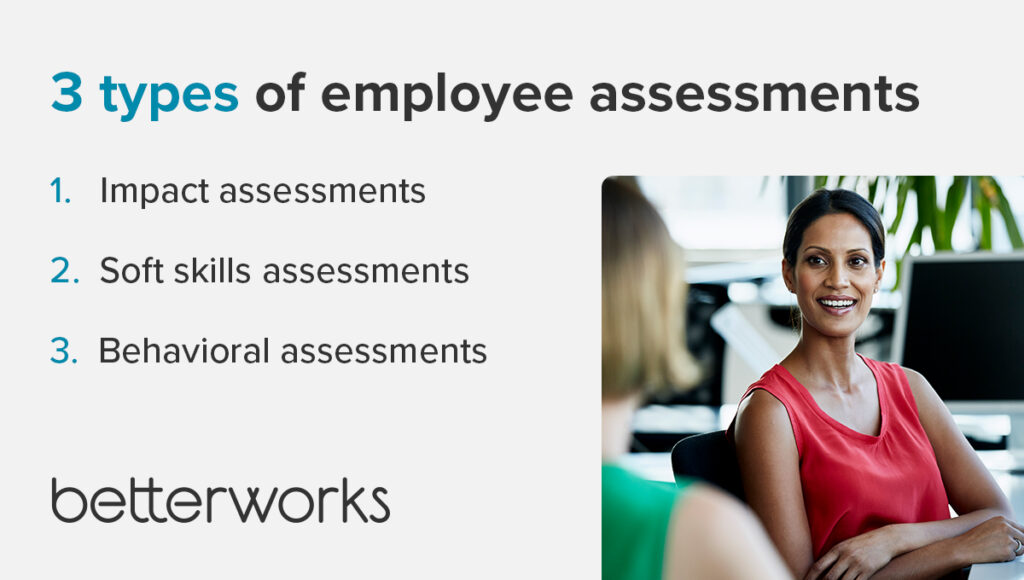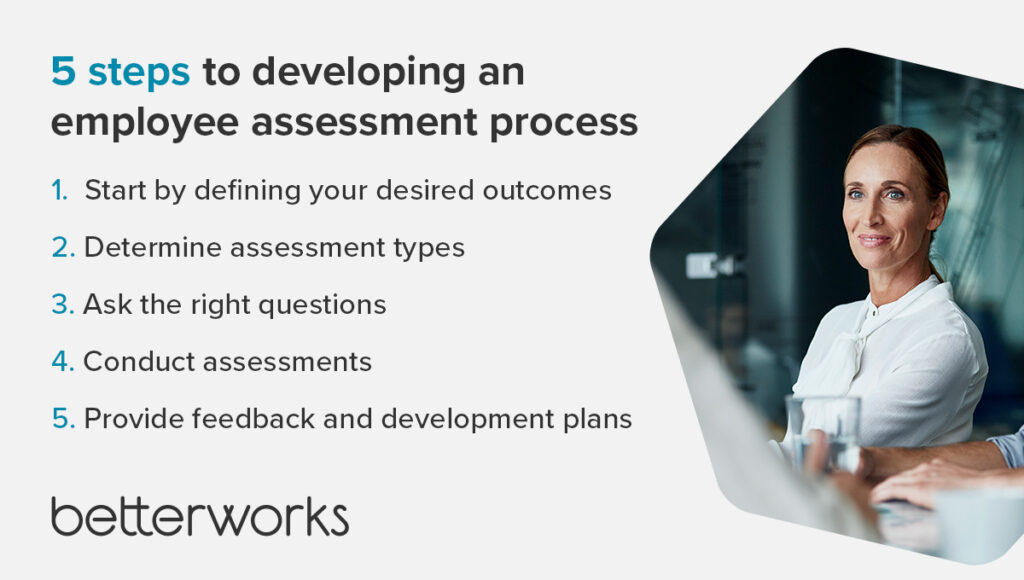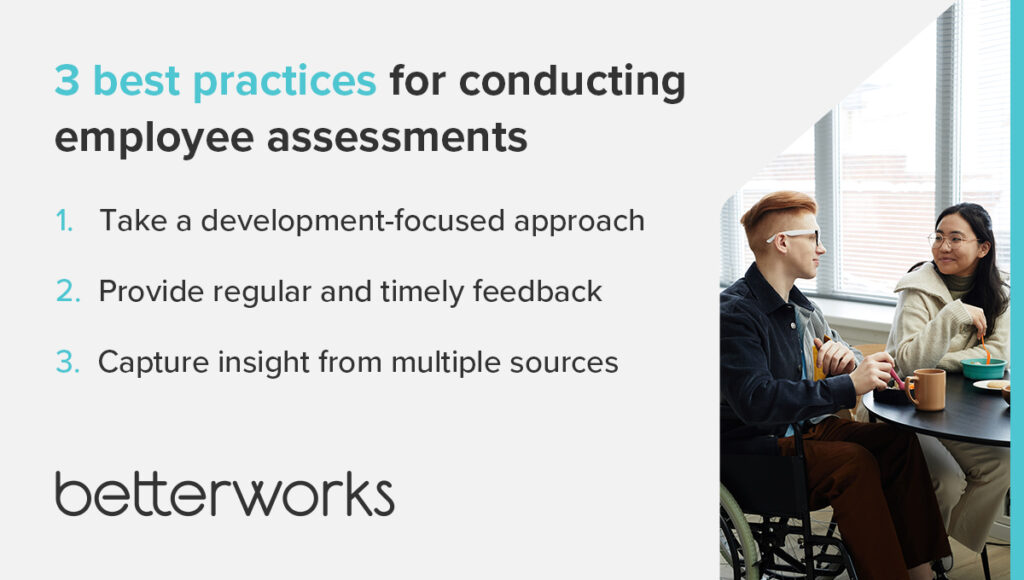Gone are the days of the one-size-fits-all assessment for employees; instead, companies are tailoring their evaluation of each employee’s impact and potential. By developing a comprehensive and thoughtful approach to employee assessments, you can help every employee drive business results.
Enterprise organizations benefit most from employee assessment strategy, especially “if it drives the growth and development of your people in the right way — in service of organizational needs,” says Caitlin Collins, organizational psychologist and Betterworks program strategy director. Assessments can help these large employers measure employee performance, including behaviors, skills, and impact, and provide direction for employee growth and development.
Learn about best practices for developing an employee assessment process that accounts for each employee’s impact and helps them identify growth avenues.
3 examples of employee assessments
There are multiple types of employee assessments, and each reveals a different perspective of someone’s performance and potential. Organizations can use multiple types of assessments to better understand employee performance and make informed decisions about development, promotions, and organizational effectiveness. Creating these assessments requires heavy lifting from HR, although generative AI can help ease some of the work. Moreover, these assessments will not fit every organization’s needs. To determine whether and how to move forward, consider the specific business needs and how assessments can serve as an evaluation tool to achieve those outcomes.
These are three key assessments to consider.
Impact assessments
Impact assessments are similar to traditional performance ratings but offer a more positive experience for employees. Impact assessments measure whether an employee’s influence on the business matches their role’s expectations — or, as Collins puts it, the employee’s impact on business goals.
While employee performance reviews and ratings are intended to measure impact, assigning numbers to worker performance can be arbitrary.
“The more impact that employees have based on their role, the more they upskill or uplevel and help collaborate with others — and that’s generally how they get promoted because they’re starting to build leadership skills,” Collins says. “Looking only at performance rating numbers can create subpar outcomes — as ratings are more prone to be subjective and biased by the reviewer. It is also a ‘look-back’ mechanism versus one that encourages future development.”
Impact assessments look at each employee’s sphere of influence, helping them see how their work creates value and aligns with their job responsibilities. Unlike a traditional rating system, this approach recognizes that even small contributions can have significant value and impact. A customer service representative might not manage people or budgets, for example. But when they resolve a customer’s concerns effectively, they’re delivering the greatest possible business value within the scope of their job description. When it comes to eCommerce, businesses can further enhance the customer experience by investing in B2C or B2B eCommerce personalization and other advanced solutions, allowing employees to focus on more strategic and value-added tasks.
Impact assessments are designed to be less subjective and less biased because they measure contributions based on an employee’s job role, rather than comparing them within a generalized metric. This assessment more accurately reinforces strengths and reinforces areas of growth, which encourages development.
“Looking only at performance rating numbers can create subpar outcomes — as ratings are more prone to be subjective and biased by the reviewer. It is also a ‘look-back’ mechanism versus one that encourages future development.”
caitlin colllins, program strategy director, betterworks
Soft skills assessments
These assessments are designed to identify an employee’s growth potential within the organization based on skills and traits that aren’t technical or role-specific. These assessments look at an employee’s readiness for new roles, ability to take on additional responsibilities, and leadership potential.
These assessments can help managers guide employees in developing the habits and behaviors necessary for career success. Many early-career employees have gaps in soft skills. These shortcomings become pronounced as people move into leadership roles.
Soft skills are gained through experience, Collins says. It’s unfair to make employees gain that experience while also acclimating to a new role. Soft skills assessments identify gaps early on so managers can help employees find opportunities to develop those skills.
“If you can start that early on, so people are developing those habits as they get put into those roles,” Collins says, “those assessments are a good way to help inform what they need to work on.”
Behavioral assessments
These assessments focus on evaluating an employee’s behavioral traits and characteristics. They should be tailored to specific roles and leadership levels. To evaluate employee performance based on behavioral traits, you need to define the exact behaviors that lead to success in each role or job function.
HR will set these parameters but should also work with managers. “While this activity is owned by HR,” Collins explains, “ HR should collaborate with managers to validate their accuracy. After all, managers are the ones closest to their employees.”
At a broader level, you can use behavioral assessments to assess and direct behaviors across the workforce.

Why do assessments matter to employee engagement?
Assessments are often used in hiring, but they have value throughout the employee life cycle. Performance management requires you to evaluate performance and potential, and assessments help measure those qualities.
Assessments also have value in other areas of talent strategy, such as employee engagement. Employee assessments help team members see how their performance aligns with expectations, as well as their unique job-relevant traits. Impact assessments give employees a deeper sense of how their work aligns with business goals and can help them feel valued for their work.
Some assessments create opportunities for managers and employees to discuss career paths, professional development, and goals. Behavioral assessments, for example, can help employees understand their potential in their current role — and what other internal roles might be a good fit.
Additionally, some assessments reveal barriers to employee engagement, allowing managers to address them. A high-potential employee struggling with soft skills, for example, can benefit from a soft skills assessment before being promoted. The assessment’s findings can prompt managers to intervene, helping the employee feel supported and stay engaged. When the employee does take the promotion, they’ll be ready for it, improving their performance and outcomes for the team and organization. Everyone involved is likely to have higher engagement — the new manager who’s ready for the responsibility, as well as that person’s reports, who feel supported and valued.

How to develop an effective employee assessment process
Developing an effective employee assessment process is crucial for effectively evaluating your workforce’s performance and potential and achieving desired outcomes. Here are five steps for designing and deploying an assessment program in your organization.
Define your desired outcomes
Don’t add assessments to your people processes without outlining your purpose. What are you hoping to achieve with the assessment process? The answer will help you determine what type or types of assessment to use.
“Are we trying to change behaviors? Are we just trying to streamline and build consistency across the organization? What are we really trying to measure?” Collins says. “What are the anchors in our HR processes that we need to tie the assessment to?”
For example, if you’re looking to issue assessments to inform decisions related to pay raises, you need to see how different assessment programs align with pay and benefits. Impact assessments, for example, align with performance evaluations.
“You’ve really got to map it out from the very beginning to have it be something that’s valuable and meaningful,” Collins says. “Communicate very transparently about what you’re doing and why it’s happening.”
After you’ve identified your purpose, communicate it clearly to the workforce so they feel comfortable engaging in the program.
Determine assessment types
Understand the behaviors, skills, and impact that you want to assess. Then, select the appropriate types of assessment that align with your objectives.
For example, if you’re a small organization that’s growing by acquiring other small businesses, your goal in implementing assessments might be to integrate these acquired companies, break down silos, and increase cross-functional collaboration. Behavioral assessments can help you determine the current state of collaboration and how to improve it.
Ask the right questions
Craft assessment questions that align with the desired behaviors and outcomes you want to measure. Make sure that the questions are clear, transparent, and easy to understand, including in different languages. Avoid idioms or unnecessary references to cultural norms, for example.
Assessment questions are most effective when tailored to specific roles. Before offering assessments, make sure that job descriptions are up to date, including the duties and skills that are essential for each role. This upfront work can help you align assessment questions with criteria relevant to each description.
Conduct assessments
Once the assessments are chosen and the questions refined, administer them to employees. You may do this through online platforms or in-person sessions so long as the process is accessible and fair for all participants.
Use the assessment results to gain insights into employees’ strengths, as well as opportunities for performance improvement. Use the results to identify training and development needs, or even where follow-up assessments might be valuable.
Provide feedback and development plans
Share assessment results with employees, and provide constructive feedback on their performance, as well as strengths and areas for improvement. Development plans to support employee growth and address the identified gaps should be collaborative. Make sure the employee has input into the plan and understands what’s being asked of them.
The goal is to help employees improve their performance, enhance their skills, and adopt new behaviors, ultimately contributing to their professional growth and the organization’s success.

3 best practices for conducting effective employee assessments
Employee assessments are more effective when conducted in the right ways and under the right circumstances. Check out these three best practices for creating a fair and transparent assessment process that fosters a collaborative and growth-oriented work environment.
Take a development-focused approach
Use assessments as an opportunity for employee development, prioritizing growth over critical evaluation. After the assessments have been taken and analyzed, collaboratively build development plans with employees that support their growth and address identified gaps.
By involving employees in the process and providing them with resources and support, you can create a culture of continuous learning and improvement, ultimately enhancing employee engagement and performance.
Provide regular and timely feedback
Keep employees informed with regular and timely feedback throughout the assessment process, just as managers do in the performance management process. Ongoing feedback and dialogue help employees understand their performance, strengths, and areas of improvement. They can, in many cases, make the necessary adjustments in the flow of work rather than wait for a formal development plan to materialize.
Regular feedback also fosters open communication and trust between managers and employees. Remember that feedback should be specific, constructive, and actionable. It should highlight areas for improvement while also celebrating achievements.
Capture insight from multiple sources
Gather feedback, data, and insights from multiple sources, including supervisors, peers, and subordinates when applicable, to gain a well-rounded view of employee performance. This approach can reduce bias, supply a wider range of information, and ultimately provide a more accurate assessment. The assessment process should help HR leaders and managers better understand each employee’s strengths and contributions to the team and organization. This is only possible when well-rounded and accurate data is collected.

Staff assessments are complete: What’s next?
After assessing employees’ skills, the next steps involve using the assessment results to drive meaningful action. Start by providing employees with feedback on their assessment performance — namely, their strengths and areas for improvement. This feedback should be constructive and specific, enabling employees to understand how they can improve their skills and contribute more effectively.
Additionally, the assessment results can help identify training and development needs. By identifying skill gaps, organizations can design targeted training programs or provide other resources to help employees acquire the necessary skills.
Furthermore, the assessment results can inform talent management decisions related to succession planning, promotions, and career development. Ultimately, the assessment process should be seen as a catalyst for organizational growth and improvement — empowering employees to reach their full potential and contribute to the organization’s success.
Employee assessments and growth
By continuously assessing and developing employees, organizations will build a resilient workforce that can adapt to any challenge. Ultimately, employee assessments spark organizational growth, enabling companies to unlock their potential and thrive in an ever-evolving business landscape.
Want to learn more? Check out our ultimate guide to improving employee performance.
Looking to improve performance?






